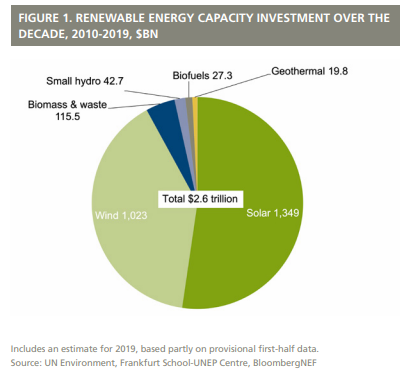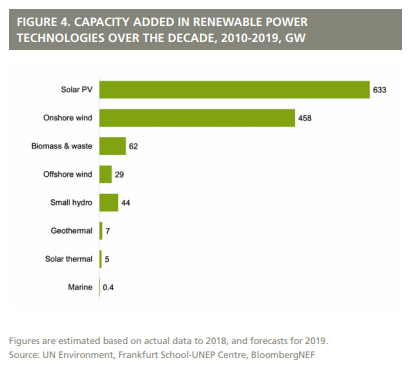
Solar’s installations worth 638 GW, added over the last decade, is a significant figure given that there was only 25 GW of solar power capacity worldwide by 2009 end
New Delhi: The world added a mammoth 638 gigawatt (GW) of solar power generation capacity, including both solar photovoltaic and thermal, between 2010 and 2019 — the largest such addition across renewable energy technologies, according to a report by the United Nations Environment Programme (UNEP).
“Solar is set to have been the most heavily installed generation technology in the 2010s with some 638 Gw added worldwide (including solar thermal as well as PV) – an astonishing result for a power source that could boast only 25 Gw of global capacity at the end of 2009,” the report said.
The report “Global Trends in Renewable Energy Investment 2019” says the 2010-2019 period is set to have seen a net 2.4 Terawatts of power capacity of all sorts installed, with solar first, coal second, and wind narrowly beating gas for third place.
The decade witnessed $2.6 trillion investment in renewable energy capacity — excluding large hydro — more than threefold the amount invested in the previous decade.
“In the renewable energy space, solar power has attracted maximum investments worth $1.3 trillion during 2010-2019, followed by wind securing $1 trillion and biomass and waste-to-energy with $115 billion,” it said.
The decade has seen a huge improvement in the cost-competitiveness of renewables, with the levelised cost of electricity for solar photovoltaics down 81 per cent, for onshore wind down 46 per cent and for offshore wind down 44 per cent.
Among regions, China remains the top country by far in terms of the sums invested in renewables capacity during the current decade. It has so far committed investments worth $758 billion, the US is on the second place with $356 billion and Japan third with $202 billion.
India, which is an increasingly important investor in renewables according to UNEP, has committed $90 billion by the end of the first half of this year.














